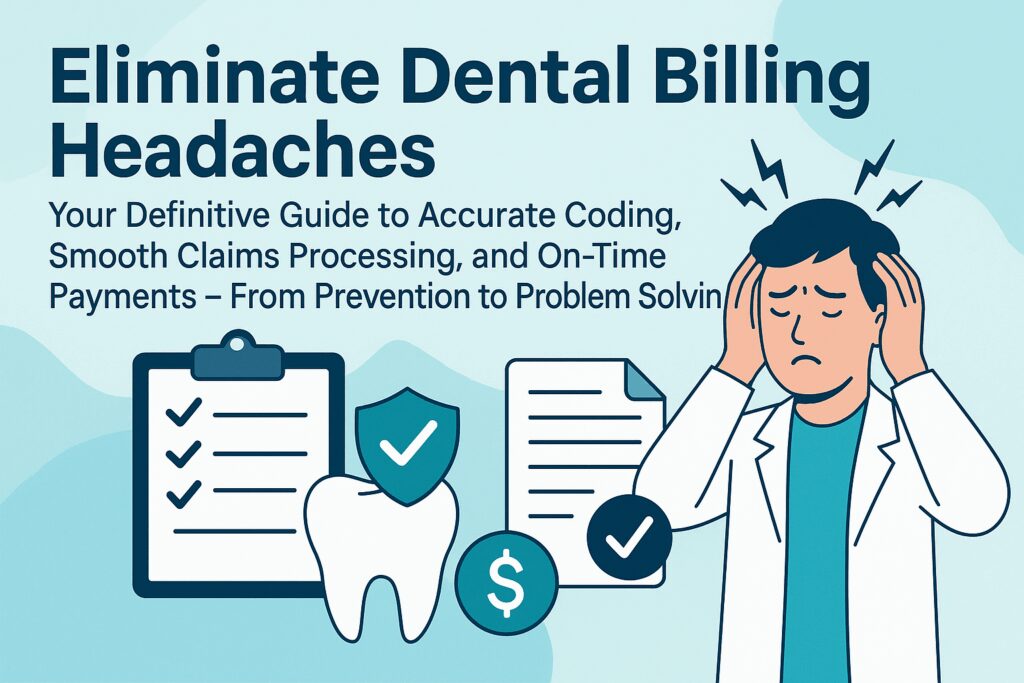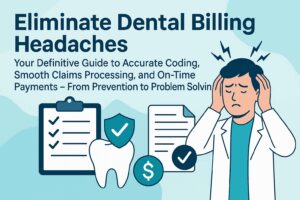
Eliminate Dental Billing Headaches: Your Definitive Guide to Accurate Coding, Smooth Claims Processing, and On-Time Payments – From Prevention to Problem Solving

Understanding the Dental Billing Process: A Step-by-Step Guide
This section outlines the key steps involved in dental billing, from patient interaction to insurance claim processing and accounts receivable management. We’ll cover essential aspects like patient registration, treatment documentation, and claim submission. A smooth and efficient billing process is crucial for the financial health of any dental practice.
Patient Registration and Treatment Documentation
This section focuses on the importance of accurate patient information and detailed treatment records for successful claims processing. Complete and accurate patient information is the foundation of a successful claim. Missing or inaccurate data can lead to delays and rejections. Similarly, detailed treatment records provide the necessary documentation to support the codes used in billing.
Coding and Claim Submission
This section covers the intricacies of dental coding, using the ADA’s CDT code set [1], and the process of submitting claims electronically. Accurate dental coding is paramount. Using the wrong code can lead to claim rejections and delays in payment. The ADA’s Current Dental Terminology (CDT) code set is the industry standard, and understanding its nuances is essential. Electronic claim submission is now the norm, offering efficiency and speed. A step-by-step guide to this process will be included.
Payment Processing and Accounts Receivable
This section discusses the payment process, managing outstanding balances, and strategies for improving payment collection. Once claims are processed, efficient payment processing is key. This includes tracking payments, managing accounts receivable, and implementing strategies to reduce outstanding balances. Proactive follow-up is crucial in minimizing delays.
Top 10 Common Dental Billing Errors & Their Causes
This section details the 10 most frequent dental billing mistakes, explaining their root causes and potential consequences. We’ll cover issues like incorrect codes, missing information, and procedural errors. Understanding these common errors is the first step towards preventing them.
- Incorrect Dental Codes: Using the wrong code is a frequent error, leading to claim rejections.
- Missing or Inaccurate Patient Information: Incomplete patient data delays processing.
- Incomplete Treatment Documentation: Insufficient records make it difficult to justify codes.
- Incorrect Procedure Codes: Errors in procedure codes result in claim denials.
- Missing or Incorrect Insurance Information: Incorrect insurance details cause delays.
- Failure to Submit Claims Electronically: Manual submissions are inefficient and prone to errors.
- Lack of Timely Follow-up on Claims: Delays in follow-up can lead to delayed payments.
- Poor Accounts Receivable Management: Inefficient management of outstanding balances impacts cash flow.
- Inconsistent Billing Practices: Inconsistent procedures create confusion and errors.
- Lack of Staff Training: Inadequate training leads to mistakes and inefficiencies.
Coding Corner: Mastering Accurate Dental Coding
This in-depth section provides a comprehensive guide to accurate dental coding, focusing on the ADA’s CDT code set [1] and best practices for preventing coding errors. Accurate coding is the cornerstone of successful dental billing.
The ADA’s Current Dental Terminology (CDT) code set [1] is the standard used by most dental insurance plans. Accurate coding is crucial for timely claim processing and payment. A detailed understanding of these codes is essential for avoiding costly mistakes. We will provide a table comparing different dental coding systems and highlight best practices for choosing the correct codes for various procedures.
Optimizing Dental Claims Management: Strategies for Smooth Processing
This section focuses on strategies for improving claim processing, including efficient claim submission, proactive claim verification, and effective communication with insurance providers. Smooth claims processing is vital for timely payments.
The Dental Practice Management Association (DPMA) [2] provides resources and best practices on improving efficiency in dental billing and financial management. Their recommendations will be incorporated into this section. We will also provide a checklist for ensuring accurate and complete claim submissions, minimizing the chances of rejection.
Improving Payment Collection and Reducing Delays: Best Practices
This section provides practical solutions for accelerating payment cycles, including efficient follow-up procedures and strategies for managing outstanding balances. Reducing payment delays is crucial for maintaining a healthy cash flow. We will explore strategies for efficient follow-up, including automated reminders and personalized communication with patients.
Leveraging Technology for Enhanced Dental Billing Efficiency
This section explores the use of technology to streamline the billing process, including dental billing software, electronic health records (EHRs), and automated payment processing. Technology can significantly improve efficiency and reduce errors. We will discuss the benefits of various software solutions and how they can automate tasks, reduce manual errors, and improve overall efficiency.
Preventing Dental Billing Errors: A Proactive Approach
This section focuses on preventative measures to minimize billing errors, including staff training, quality control systems, and regular audits. A proactive approach is more effective than reactive problem-solving. We will discuss the importance of staff training, outlining key areas to focus on. We will also explore the implementation of quality control systems and regular audits to identify and address potential issues early on.
Resolving Billing Disputes and Rejected Claims: A Step-by-Step Guide
This section provides practical strategies for resolving billing disputes and appealing rejected claims, including sample appeal letters and communication strategies. Knowing how to handle rejected claims is crucial. We will provide a step-by-step guide to appealing rejected claims, including sample appeal letters and tips for effective communication with insurance providers.
Conclusion
This article provided a comprehensive guide to eliminating dental billing headaches. By implementing the preventative measures and solutions discussed, you can achieve accurate coding, smooth claims processing, and on-time payments.
Ready to optimize your dental billing process? Contact us today for a free consultation!
References
- American Dental Association (ADA). (2025). ADA Codes. Retrieved from https://www.ada.org/publications/ada-professional-resources/coding
- Dental Practice Management Association (DPMA). (2025). Dental Practice Management Association. Retrieved from https://www.dpma.org/
Contact Us
Phone: 908-357-1515
111 Town Square Pl, Suite 1203 Jersey City, NJ 07310












